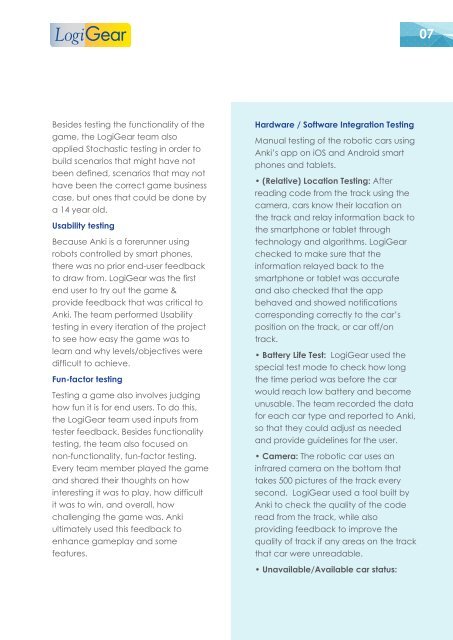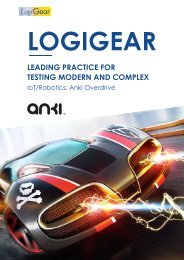Anki White Paper
Create successful ePaper yourself
Turn your PDF publications into a flip-book with our unique Google optimized e-Paper software.
07<br />
Besides testing the functionality of the<br />
game, the LogiGear team also<br />
applied Stochastic testing in order to<br />
build scenarios that might have not<br />
been defined, scenarios that may not<br />
have been the correct game business<br />
case, but ones that could be done by<br />
a 14 year old.<br />
Usability testing<br />
Because <strong>Anki</strong> is a forerunner using<br />
robots controlled by smart phones,<br />
there was no prior end-user feedback<br />
to draw from. LogiGear was the first<br />
end user to try out the game &<br />
provide feedback that was critical to<br />
<strong>Anki</strong>. The team performed Usability<br />
testing in every iteration of the project<br />
to see how easy the game was to<br />
learn and why levels/objectives were<br />
difficult to achieve.<br />
Fun-factor testing<br />
Testing a game also involves judging<br />
how fun it is for end users. To do this,<br />
the LogiGear team used inputs from<br />
tester feedback. Besides functionality<br />
testing, the team also focused on<br />
non-functionality, fun-factor testing.<br />
Every team member played the game<br />
and shared their thoughts on how<br />
interesting it was to play, how difficult<br />
it was to win, and overall, how<br />
challenging the game was. <strong>Anki</strong><br />
ultimately used this feedback to<br />
enhance gameplay and some<br />
features.<br />
Hardware / Software Integration Testing<br />
Manual testing of the robotic cars using<br />
<strong>Anki</strong>’s app on iOS and Android smart<br />
phones and tablets.<br />
• (Relative) Location Testing: After<br />
reading code from the track using the<br />
camera, cars know their location on<br />
the track and relay information back to<br />
the smartphone or tablet through<br />
technology and algorithms. LogiGear<br />
checked to make sure that the<br />
information relayed back to the<br />
smartphone or tablet was accurate<br />
and also checked that the app<br />
behaved and showed notifications<br />
corresponding correctly to the car’s<br />
position on the track, or car off/on<br />
track.<br />
• Battery Life Test: LogiGear used the<br />
special test mode to check how long<br />
the time period was before the car<br />
would reach low battery and become<br />
unusable. The team recorded the data<br />
for each car type and reported to <strong>Anki</strong>,<br />
so that they could adjust as needed<br />
and provide guidelines for the user.<br />
• Camera: The robotic car uses an<br />
infrared camera on the bottom that<br />
takes 500 pictures of the track every<br />
second. LogiGear used a tool built by<br />
<strong>Anki</strong> to check the quality of the code<br />
read from the track, while also<br />
providing feedback to improve the<br />
quality of track if any areas on the track<br />
that car were unreadable.<br />
• Unavailable/Available car status:



